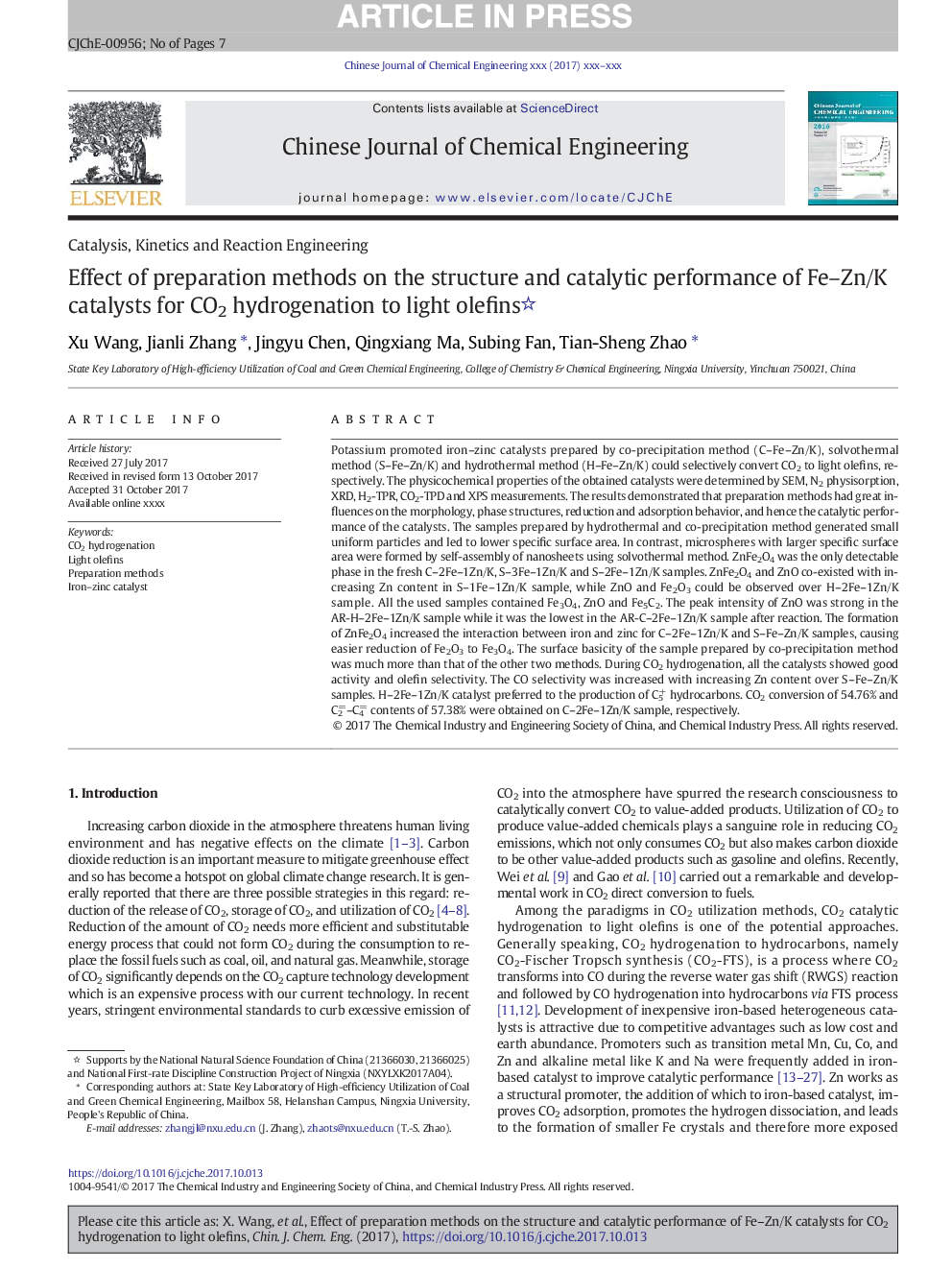| کد مقاله | کد نشریه | سال انتشار | مقاله انگلیسی | نسخه تمام متن |
|---|---|---|---|---|
| 6592983 | 1423365 | 2018 | 7 صفحه PDF | دانلود رایگان |
عنوان انگلیسی مقاله ISI
Effect of preparation methods on the structure and catalytic performance of Fe-Zn/K catalysts for CO2 hydrogenation to light olefins
دانلود مقاله + سفارش ترجمه
دانلود مقاله ISI انگلیسی
رایگان برای ایرانیان
کلمات کلیدی
موضوعات مرتبط
مهندسی و علوم پایه
مهندسی شیمی
مهندسی شیمی (عمومی)
پیش نمایش صفحه اول مقاله

چکیده انگلیسی
Potassium promoted iron-zinc catalysts prepared by co-precipitation method (C-Fe-Zn/K), solvothermal method (S-Fe-Zn/K) and hydrothermal method (H-Fe-Zn/K) could selectively convert CO2 to light olefins, respectively. The physicochemical properties of the obtained catalysts were determined by SEM, N2 physisorption, XRD, H2-TPR, CO2-TPD and XPS measurements. The results demonstrated that preparation methods had great influences on the morphology, phase structures, reduction and adsorption behavior, and hence the catalytic performance of the catalysts. The samples prepared by hydrothermal and co-precipitation method generated small uniform particles and led to lower specific surface area. In contrast, microspheres with larger specific surface area were formed by self-assembly of nanosheets using solvothermal method. ZnFe2O4 was the only detectable phase in the fresh C-2Fe-1Zn/K, S-3Fe-1Zn/K and S-2Fe-1Zn/K samples. ZnFe2O4 and ZnO co-existed with increasing Zn content in S-1Fe-1Zn/K sample, while ZnO and Fe2O3 could be observed over H-2Fe-1Zn/K sample. All the used samples contained Fe3O4, ZnO and Fe5C2. The peak intensity of ZnO was strong in the AR-H-2Fe-1Zn/K sample while it was the lowest in the AR-C-2Fe-1Zn/K sample after reaction. The formation of ZnFe2O4 increased the interaction between iron and zinc for C-2Fe-1Zn/K and S-Fe-Zn/K samples, causing easier reduction of Fe2O3 to Fe3O4. The surface basicity of the sample prepared by co-precipitation method was much more than that of the other two methods. During CO2 hydrogenation, all the catalysts showed good activity and olefin selectivity. The CO selectivity was increased with increasing Zn content over S-Fe-Zn/K samples. H-2Fe-1Zn/K catalyst preferred to the production of C5+ hydrocarbons. CO2 conversion of 54.76% and C2=-C4= contents of 57.38% were obtained on C-2Fe-1Zn/K sample, respectively.
ناشر
Database: Elsevier - ScienceDirect (ساینس دایرکت)
Journal: Chinese Journal of Chemical Engineering - Volume 26, Issue 4, April 2018, Pages 761-767
Journal: Chinese Journal of Chemical Engineering - Volume 26, Issue 4, April 2018, Pages 761-767
نویسندگان
Xu Wang, Jianli Zhang, Jingyu Chen, Qingxiang Ma, Subing Fan, Tian-sheng Zhao,